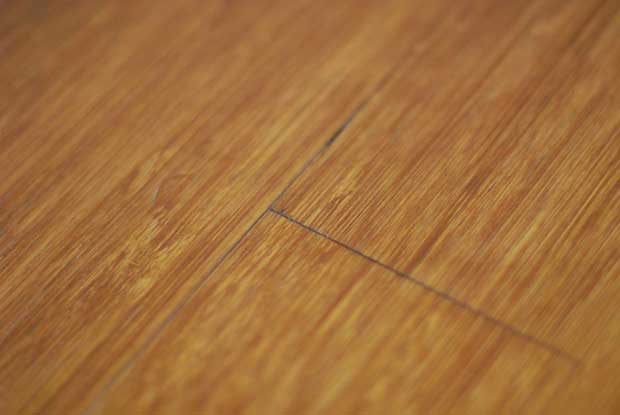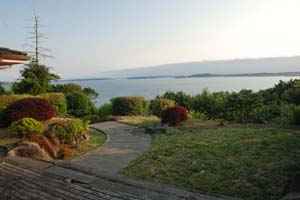The bamboo floor saga
A couple of weeks ago, I posted about the concrete floor saga. Unfortunately, this wasn’t the only “adventure” related to the flooring throughout the house. The whole bamboo situation was arguably even more stressful. I’ll start from the beginning.
In deciding what sort of wood to use on our floors, the girlfriend and I both dug bamboo for its modern, natural appearance and its sustainability (bamboo is actually a grass and not a wood). We would have been perfectly fine with a nice durable hardwood like brazilian cherry but bamboo was the first choice. In researching bamboo, the first thing we discovered was the janka scale. The janka scale measures the hardness of wood and is the primary indicator of how easily your floors will dent. I have a friend with a cheap, engineered bamboo floor and he swears he can dent the thing just by dropping his keys on it. This cheap bamboo is likely in the 1100-1200 janka range and is super-thin as well, making it a poor candidate for durable flooring.
On the other end of the scale is strand woven bamboo. Weighing in at 3000 or more on the janka scale, only a few woods are harder. Strand bamboo has a distinctive look to it that you may or may not be into, but it’s virtually indestructible, so we specified it.
The first misstep in the bamboo saga occurred here.
The wrong bamboo was ordered. Instead of receiving strand bamboo, we received Teragren Signature Naturals vertical grain caramelized bamboo in 3/4 inch thickness. While the non-caramelized variety averages a healthy 1876 janka, the caramelized version is about 30% softer (caramelizing or “carbonizing” is the process of cooking bamboo so that it darkens naturally, the side effect being that it softens). Since the bamboo looked really nice and was a from Teragren, a company known for its quality, we decided to see if we could just exchange the caramelized stuff for non-caramelized.
The distributor agreed to make the exchange and we then accepted a new shipment of non-caramelized bamboo, which we’d just darken via staining. The color we were going for was slightly darker than natural blonde bamboo; a color sometimes referred to as “honey”.
Here is when the real (non) fun started.
When the company doing our floors laid the first coat of stain down, the edges of each floor board collected stain in a manner inconsistent with the faces of the planks. The result was a light colored floor (good) with dark outlines around each board (terrible). One of the many reasons we went with a site-finished floor instead of a pre-finished floor was so the floor would be one even, seamless, gapless piece of awesomeness.

A close-up of the darkness between boards. The inital stain was much lighter than this so you can see how these seams would ruin the appearance.
The flooring company, recognizing the problem, offered to re-sand the whole floor and lay down a different treatment. Unfortunately, however, every attempt to slightly darken the floor resulted in these unsightly outlines around the boards.
I then began calling around to other flooring companies, including a very highly regarded one on Bainbridge Island, and to my surprise, some companies told me they refuse to stain bamboo for this very reason. Apparently, stain does not take evenly to bamboo and getting it to look right is more trouble than it’s worth.
Would have been great to know ahead of time! Especially from the flooring installer!
Faced with this new information, we had two choices: keep the floor blonde or stain it much darker so the dark spots between the boards would blend in. We ended up choosing the latter.
Unfortunately the fun didn’t end there either.
When the stain went down, we were actually pleasantly surprised with the look. It was more or less the color of teak, which is kind of original for a bamboo floor. When it dried the following day, the entire floor had to be covered up with protection so the rest of construction could continue (much like with the concrete floor). I noticed what I thought were some shoeprints around the edges of the walls, but since the flooring company had to come back in a few months to do the topcoat, I figured it would get fixed at that time.
When the construction started wrapping up a few months later, the flooring company came back out to put a swedish finish top coat on. Unfortunately, not only did they coat over the shoeprints, but they actually weren’t shoeprints. Turns out they were “chattermarks” and they were all around the perimeter of the main floor. Chattermarks are essentially scratches in the surface caused by subpar sanding. The stain from the bamboo collected inside the scratches and that’s why they looked like shoeprints.
When I complained, the flooring company came back out and tried to repair the situation using some floor tint, but it only made things worse. Although I hate making people redo work, the owner of the company agreed that this was not up to his company’s quality standards and that they would re-sand the entire floor again and make things right.
Although it ended up adding another week or so to the construction schedule, the floor was re-sanded and the situation was resolved. We now have a beautiful, teak-colored, site-finished bamboo floor, that should be hard enough to withstand thousands of key drops and other accidents.

The finished floor looks really great, and although it was a long process, it turned out beautiful.
Lessons learned
- If you choose a bamboo floor, either stain it dark or don’t stain it at all. Plenty of colors are available if you go pre-finished, but site-finished floors are generally regarded as higher quality. If you are looking at strand bamboo, the two best samples I found were from Plyboo and Duro Design.
- Investigate the janka rating of whatever material you’re thinking about and choose something above 1500 unless you don’t care about denting.
- Quiz your flooring company and find out if they’ve ever worked with the product you’ve chosen. If I had known the company doing my floors had never stained bamboo before, I would have either chosen a different product or a different flooring company. Companies may not volunteer that they’ve never worked with a certain product before because they assume it’s not much different than what they’re used to.
- Just like with the concrete floor situation, let your installer know right away if you’re not happy with something about their installation. You may still both agree to deal with it at a later date when construction schedules permit, but get it on their radar and hold back an appropriate percentage of payment until it is dealt with.
Costs accrued during this stage:
| Bamboo flooring (parts and labor) | $23,146.00 |


thanks for sharing! just out of curiosity–the “honey” photo you link to is from a company called “Ecotimber”, which I am actually specifying on a project currently under construction.
It sounds like you guys loved the “honey” color, but was their a reason why you guys did not actually go with the “woven”ecotimber product?
Archalto: Yep… the Ecotimber is pre-finished and has micro-beveled edges. I wanted a seamless, flat edged floor. Other than that, the stuff looks pretty good.
Ah! so it is… I must have missed that in the specs.
I assume another advantage is being able to sand and re-finish after a few years of wear and tear.
The installed floor looks beautiful in the photos above…this post has prompted me to look into the site finished bamboo flooring alternatives.
Thanks.
Bamboo is such a pain! What stain did you end up using on the floor? We are going through this problem on a current project and I cannot find a dark stain.
Thanks.
Josh.
Josh: Don’t know what the actual stain was. It’s teak/walnut colored and technically it’s a swedish finish. Don’t use that aluminum oxide stuff because it scratches white.
Thanks Mike, we are looking into Low VOC stains and cannot find too many that are dark. Love the article, btw! Josh.
My husband and I are hopefully purchasing our first home and it has bamboo flooring in a light honey color and we really prefer a dark walnut color. Researching on whether or not we can just stain them I came across your website. Would you suggest not to bother and just buy new flooring. The floors are in great condition they are just not our taste.
Alisha,
I would just call around and find someone who has stained bamboo floors before. Make sure they have actually *done* it… not that they *will* do it. If you find someone who has done it before and is willing to do it again, you should be fine.
As I said, ours turned out great… just took two tries.
I have a problem with our bamboo floor that was blond but turned much darker aver 4 years. We also had some water damage that turned the floor along the water leak wall black. I had damged area removed and new planks installed but it is obvious in the difference of the light new floor and old floor. As an experiment I tried to stain some spare light bamboo after removing the clear finish but bamboo does not absorb the stain well. I tried various brands of stains but had the same result.
Anyone with same problem please let me know how you resolved your different floor colour. I don’t really want to sand 1100 sq ft of floor and go through the mess that sanding creates.
Put the new bamboo out in the sun and it should darken – just be sure to check it often when it is getting close to the color of your existing floor. UV that is filtered through windows will still darken the bamboo, but much more slowly than direct sunlight.
I just did a quick check to verify and saw that while natural bamboo darkens in the sun, caramelized bamboo lightens in the sun.